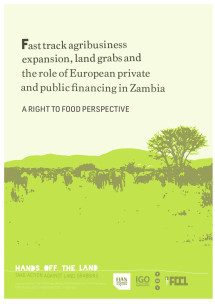Ideas into movement
Boost TNI's work
50 years. Hundreds of social struggles. Countless ideas turned into movement.
Support us as we celebrate our 50th anniversary in 2024.

What are the effects of the climate crisis, the food price crisis, the energy (or fuel) crisis and the financial crisis on land and the food system in Zambia?

Introduction
Today it is widely accepted that land grabbing is not really a new phenomenon but the latest rush for land and related resources like water, which has its own distinct features. It must be seen in the context of multiple global crises: The climate crisis, the food price crisis, the energy (or fuel) crisis and the financial crisis. Some scholars specify that land grabbing is a “response to the convergence of [these] multiple crises” where a fast track land concentration is one of the defining features.
This response to those crises is a response primarily by different types of powerful actors. It creates or reinforces their specific interests. The enforcement of these interests today is increasingly linked to the control of natural resources, especially land and water. Without being exhaustive, some key interests are:
The global food system thus can be understood as an important arena where actors cope with the crisis. A vast body of evidence today shows that these coping strategies –the enforcement of the related interests – are accompanied by sometimes extremely brutal conflicts over land and water with existing local land users. Less attention is given to the underlying deep structural transformation where local population, especially local land users, does not play a role at all - or just an ancillary one. Plans from the World Bank blatantly underpin the implications. In its 2011 publication on land grabbing the bank proposes for example the expansion of maize cultivation on 148 million hectares land globally that has a very low population density. They calculate some 10 jobs for 1,000 hectares prospecting 1.48 Million jobs globally.
Following the bank’s own numbers some 11.7 million people – almost a tenfold number - actually sustain their livelihood on those 148 million hectares. They would most probably be negatively affected by such a massive transformation. For Zambia, for example, the World Bank identifies 13 million hectares available for maize expansion alone.
Apart from a fast track land concentration, the intensified financialisation of the global food system is an additional structural feature. In the past, the majority of agribusiness companies and financial investors refrained from participat- ing in agricultural production itself. Intense concentration happened upstream and downstream the value chain: in the input market (seeds, fertilizer and agrochemicals), trade, processing and retail. The concentration process in the global food system largely ignored farming itself. This is why land is now seen as one of the last investment frontiers by the financial world.
The extensive entrance of financial actors in agricultural production thus is new and entails concrete changes. One of these changes is that the distance between the financial investor and effects of an investment increases " in ways that makes the political context for opposition to financialisation is especially challenging." Clapp (2013) summarizes that this distance tends "to obscure the role that financial actors play in the food system, making it difficult to link them to the social and ecological consequencesof financial investment activities on the ground". From a human rights perspective accountabilty issuesand state obligations vis-à-vis possible problemtaic food system outcomes are harder to address, e.g. "Who holds responcibilty for a specific forced eviction, human rights violation...?"
Consequently, recent cholars' discussons are asking for further research adressing "where and how [financial actors] are investing, via whom, and what kind of land uses and social relations are being produced through this influx of global capital"? This study tries to shed some light on these questions and contribute to unpacking the distance (and with it the problem of accountabilty) by looking into the case of Zambia and its linkage to European finances involved.
This study will not look at the financialisation in the context of agricultural commodities, commonly referred to as food speculation. It will take a look at the agricultural production itself, which in many cases takes the form of land grabbing. the perspective on finances also helps including a second aspect of sclae. Apart from the strong focus on the mainstream debates on the sice of land targeted or affected by this development, the scale of capital involved is as another key aspect.